Athena Golden
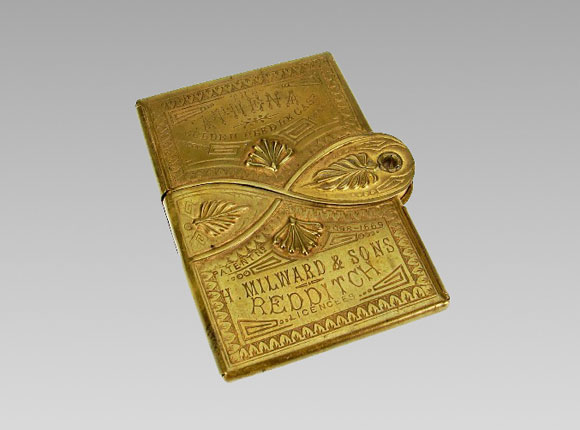
Needle Case (photographs courtesty of Bunny's Place)
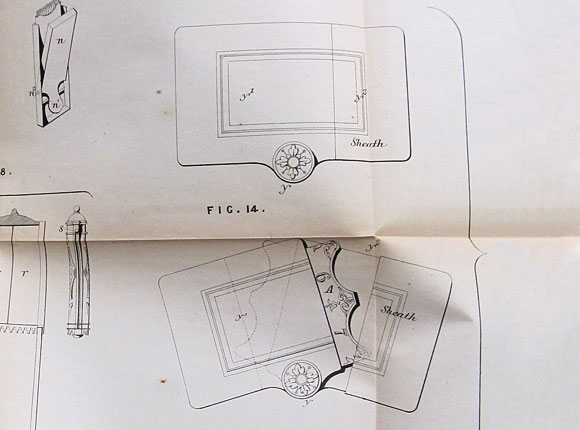
Patent # 2998 (this patent number is stamped on the actual needle case)
Design Details
Needle Case Type: |
Flat-Names |
Patent/Registered to: |
William Avery - Redditch Manufacturer and Albert Fenton of the same place, Machinist |
Patent/Design Representation #: |
Mechanical Patent #: 2998 (Fig. 14) |
Patent/Design Registration Date: |
October 14, 1869 |
Location of Patent/Design Registration: |
British Library - Business and Intellectual Property Centre - London
|
Reference #: |
1869-2998 |
Dimensions: |
5.3 x 0.5 x 6.7 |
Material: |
Brass |
Name Variations: |
a) Copestake, Moore, Crampton & Co - London
b) H. Milward & Sons - Redditch
c) Pratt & Farmer - New York
d) W. Avery & Son - Redditch |
Other Variations: |
a) Athena without Minerva Head
b) Athena with Minerva Head on one side (the sole source of this information is Horowitz and Mann as no example of this needle case
with this company name has been seen by the authors of this website)
c) Athena with Minerva head on both sides
d) Stella Golden |
Additional Photographs
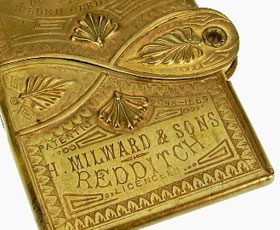
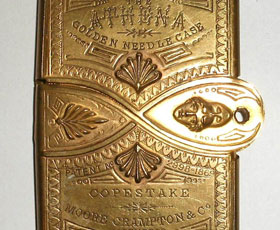
Milward signature and Copestake signature details
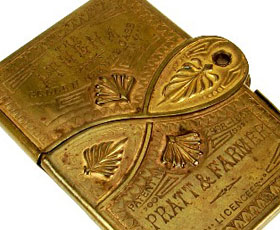
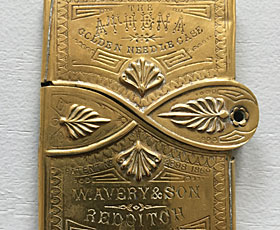
Pratt & Farmer signature detail and Avery signature detail (photo courtsey of Kirsten Nørgaard)
Facts
Athena is the goddess of wisdom, courage, inspiration, civilization, law and justice, strategic war, mathematics, strength, strategy, the arts,
crafts, and skill in Greek mythology. Ancient Greeks worshiped her in many roles through a series of epithets or descriptive titles
incorporated into her name. For example as Athena Parthinos or the virgin Athena, she is the patroness of Athens and the Parthenon on the
Acropolis is the temple dedicated to her. Sometimes depicted as a young woman wearing a helmet, her equivalent is Roman mythology is Minerva.
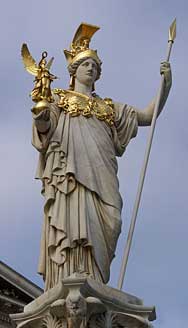
History
In classic mythology Athena was the daughter of Zeus born from her father’s forehead. It has been proposed that her origins can be traced
from much older deities from other cultures. She is often depicted with a small owl an association which represents wisdom and possibly an
iteration of the goddess in earlier times. The association has survived today with the owl a symbol of wisdom. The olive tree is sacred
to Athena. The mythological tale to explain this relates to a rivalry between Athena and her uncle Poseidon to gain the affections of the
Greeks. Each gave a gift, Poseidon a salt water spring where he struck his trident and Athena the olive tree. The people chose the
olive tree with its uses of fruit, oil and shade over the salty undrinkable water so named Athens for Athena.

Miscellaneous
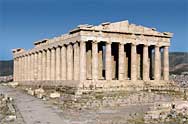
The Parthenon, though now substantially in ruins, is considered to be the finest example of Greek architecture and one of the world’s greatest
cultural monuments. Built between 447 BC and 438 BC with decoration continuing a further 6 years, on the site of an earlier temple to Athena,
it stood until 1687 when it was extensively damaged. The Ottoman Turks had used it as a gunpowder magazine and when a Venetian assault ignited
this, the resulting explosion caused catastrophic damage. Although dedicated to Athena the building primary function was a treasury for gifts
offered to the gods as indicated by the use of high relief metopes, carved panels around the outside walls, until then only used on treasury
buildings. Looting of the site started with the Venetians who began the removal of sculptures. Some 15 of the metopes are part of the
Elgin marbles along with 17 items of statuary and 75 meters of the original 160 meters the bas relief frieze that decorated the exterior wall of
the cella or inner structure.
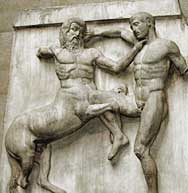
Note: Right side panel text and photos provided by Lynda Herrod.














